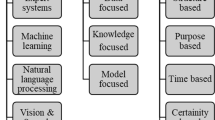Abstract
The report briefly describes the consecutive steps in the identification, assessment and comparison of hazards and associated risk. These techniques can be helpful in setting the priorities for the decision on measures to reduce risk.
When quantifying risk for the comparison of alternative cases, the use of a consistent data base is stressed. It is pointed out that the risk assessment techniques described in the report, although potentially valuable tools for improving overall safety performance, have short-comings particularly in dealing with human factors.
A glossary is appended to define terms as they are used in this report and a list of recommended further reading is included.
Part I appeared inFire Technology, August 1984.
Similar content being viewed by others
References
Davenport, J. A., “A Survey of Vapor Cloud Incidents,”Chemical Engineering Progress, September 1977.
UK Health and Safety Commission,Newsletter No. 19, August 1981, London, H.M.S.O.
U.S. National Safety Council,Accident Facts, 1980 Edition.
Balemans, A. W. M. et al., “Checklist: Guidelines for Safe Design of Process Plants,” in:Preprints of the 1st International Loss Prevention Symposium, Elsevier, Amsterdam, May 1974.
American Institute of Chemical Engineers,Dow's Fire & Explosion Index, Hazard Classification Guide, 5th Edition, LC 80029237, 1981.
Lewis, D. J., “The Mond Fire, Explosion and Toxicity Index Applied to Plant Layout and Spacing,”Loss Prevention, Vol. 13. New York, 1980.
Munday, G., et al., “Instantaneous Fractional Annual Loss — a Measure of the Hazard of an Industrial Operation,” Paper presented at the 3rd International Symposium on Loss Prevention and Safety Promotion in the Process Industries, Basel, Switzerland, September 1980.
Lawley, H. G., “Loss Prevention: Operability Studies and Hazard Analysis,”Chemical Engineering Progress, Vol. 70, No. 4.
Fussell, J. B., “Fault Tree Analysis — Concepts and Techniques,” inGeneric Techniques in Systems Reliability Assessment. Ed. by Henley, E. J. and Lynn, J. W., Amsterdam, Noordhoff.
Lambert, H. E., et al., “Material Control Study: A Directed Graph and Fault Tree Procedure for Adversary Event Set Generation,” in: NATO Advanced Study Institute on Synthesis and Analysis Methods for Safety and Reliability Studies. Urbino, Italy, 415–435.
Sobol, I. M., “The Monte Carlo Method,” University of Chicago, 1974.
Embrey, D. E., “Approaches to the Evaluation and Reduction of Human Error in the Process Industries,” Institution of Chemical Engineers Symposium Series No. 66.
Swain, A. D., “THERP: Report SC.R. 64.338,” Sandia Laboratories, Albuquerque, NM, 1964.
UK Health and Safety Executive. “An Investigation of Potential Hazards from Operations in the Canvey Island/Thurrock Area,” London, H.M.S.O., 1978.
UK Health and Safety Executive, “A Safety Evaluation of the Proposed St. Fergus to Moss Morran Natural Gas Liquids and St. Fergus to Boddam Gas Pipelines,” London, H.M.S.O.
Swain, A. D.,Design Techniques for Improving Human Performance in Production, Revised ed., Sandia Laboratories, Albuquerque, NM.
Swain, A. D. and Guttman, H. E.Handbook of Human Reliability Analysis with Emphasis on Nuclear Power Plant Applications Report Nureg/CR-1278, Sandia Laboratories, Albuquerque, NM.
Ablitt, J. F.,An Introduction to the “Syrel” Reliability Data Bank, UKAEA Report SRS/GR/14, 1973.
T.N.O. Industrial Safety Data Bank,Failure of Accidents Technical Information System (FACTS), for Incidents with Hazardous Materials (in English), Apeldoorn, The Netherlands.
Incident Sequence Analysis; Event Tree, Method and Graphical Symbols, DIN 25, 419, part 1 1979. Probabilistic evaluation, DIN 25, 419, part 2 1979.
Additional information
Prepared by the Ad-Hoc Risk Assessment Group of the Oil Companies' International Study Group for Conservation of Clean Air and Water in Europe (CONCAWE)
Reference: CONCAWE's Ad-Hoc Risk Assessment Group; “Methodologies for Hazard Analysis and Risk Assessment in the Petroleum Refining and Storage Industry, Part II,” Fire Technology, Vol. 20, No. 4, November 1984, p. 43
Rights and permissions
About this article
Cite this article
Hope, S., Eddershaw, B.W., Joanny, L. et al. Methodologies for hazard analysis and risk assessment in the petroleum refining and storage industry — Part II. Fire Technol 20, 43–56 (1984). https://doi.org/10.1007/BF02389992
Issue Date:
DOI: https://doi.org/10.1007/BF02389992




